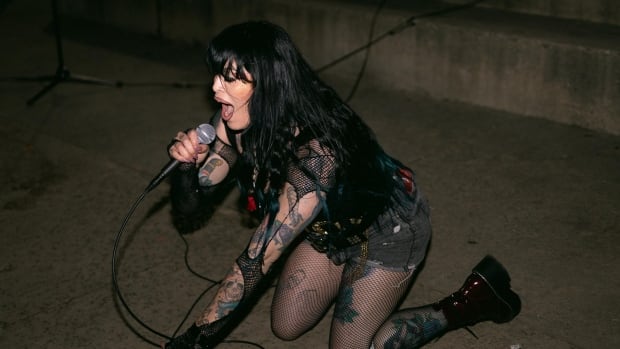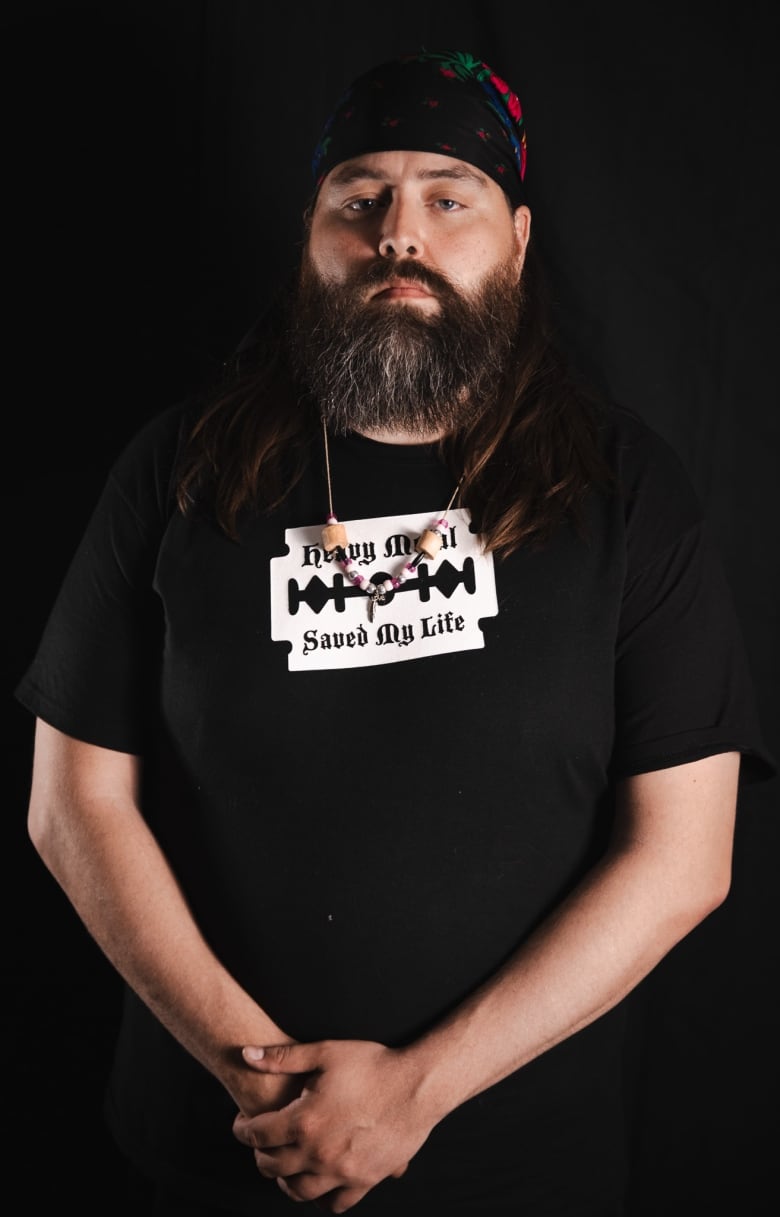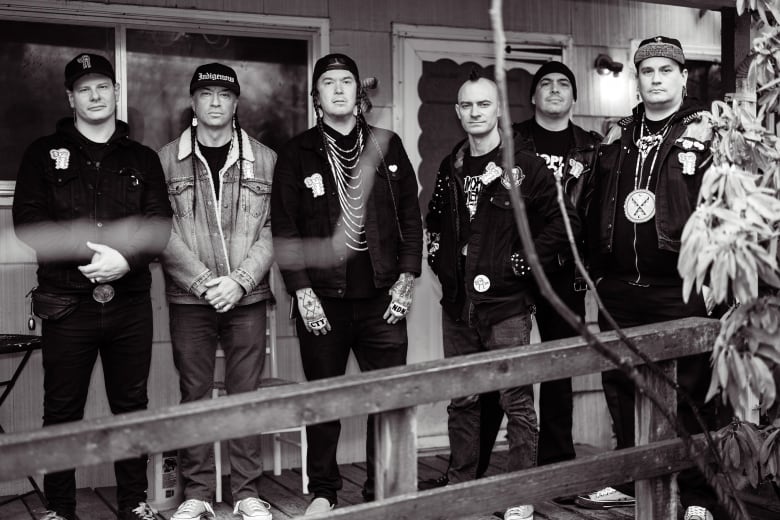
Unreserved56:39Indigenous influence on the punk music scene
Kristy Martinez has loved punk music since she was in high school 20 years ago. Then, the fashion and the rebellious ideology felt like “armour,” she says.
But when Martinez — an Azusa, Calif., resident who is of Chicana and Yaqui descent — realized that Indigenous people have been making punk music since around when the scene emerged in the mid 1970s, it opened a world she didn’t know existed.
Martinez was watching a punk music documentary when she noticed a flyer advertising a show by the band Los Crudos near Flagstaff, Ariz., in one of the shots. The poster, which depicted a simple, black and white sketch of a cartoon punk rocker with long hair, was for a “rez show” 30 miles outside of the town on the Navajo nation. Martinez remembers pausing the documentary in awe, trying to get a closer look at the poster — and the Indigenous art that it depicted.
“It just was like … ‘Where are these shows? Why doesn’t [mainstream] punk talk about these?'” said Martinez. She remembers feeling a mix of joy at discovering the cultural connection, and anger that this part of the music’s history was so hidden.
That discovery inspired Martinez to focus her ongoing PhD research at UCLA on the lost history of Indigenous involvement in punk rock.
She shares her research on Instagram, as well, so that the history she worked so hard to uncover doesn’t get forgotten again: The Indigenous Punks Archive account features headbanging aunties, backyard rez shows and lots of mohawks. Martinez says she hopes to uplift Indigenous artists in the genre and remind hard rock listeners that Indigenous people and ideas have always been part of punk.
Martinez and her co-administrator, Cass Gregg, post news clippings, band posters, concert videos, merch and more from Indigenous groups past and present — both that they’ve found through research and through submissions from their community of followers.
Martinez didn’t expect many people to pay attention to the archive, but it’s now amassed almost 5,000 followers, many of whom have expressed amazement at what they learn about Indigenous punk rockers.
“You just see [new followers] going like, ‘Wow, I love this. I can’t believe all this stuff,'” Gregg told Unreserved host Rosanna Deerchild. Gregg says helping punk fans learn something new is the best part about working with the archive.
Indigenous punks over the decades
Indigenous ideals have always been part of punk — both brought in by Indigenous punk rockers themselves, and adopted by non-Indigenous musicians, according to Gregg and Martinez.
The subgenre of anarcho-punk specifically included themes like animal welfare, environmental sustainability and political causes that Martinez says were inspired directly by Indigenous culture.
Martinez says the band Flux of Pink Indians is a prime example — they gave themselves that title because they said they “felt strongly about the Indians over in America, and the way they were being treated.”
Derek Birkett, a founder of the band who isn’t Indigenous himself, has also said that Indigenous philosophies of care were greatly influential to the anarchist punk movement, and invoked Indigenous people in his record label, One Little Indian Records. (Birkett changed the name to One Little Independent Records in 2020 after a fan letter made him realize the name and logo both “contribute to racism.”)
And arguably the ultimate symbol of punk culture, the mohawk, is an Indigenous hairstyle. It’s also named after the Mohawk nation, though the Pawnee people actually wore a mohawk-type hairstyle more frequently.
“That’s a tribal haircut. Very sacred, very important,” said Martinez.
Music reflects band members’ experiences
Indigenous bands hit the punk scene in the ’80s, according to Martinez, especially around Flagstaff.
Bands like Blackfire — founded in 1989 by three siblings, Jeneda, Klee, and Clayson Benally — made music that reflected their own nation’s struggles, as well as those they endured as Indigenous people.
A land settlement act passed in 1974 forced Diné and Hopi people off of their land in the Black Mesa area of Navajo County, Ariz., and gave Peabody Energy exclusive rights to mine coal there. Despite pressure to leave, some families, including the Benallys, resisted the move and have never given up their lands.
“At that time, there was a lot of hardships, you know. We were in the courts and … our elders were trying to preserve our traditional ways of life and prevent forced relocation,” Clayson told Unreserved. (Blackfire went on hiatus in 2012, though Clayson and Jeneda perform together these days as a duo under the name Sihasin.)
Translating their experience into punk — a “raw” and “unfiltered” genre, as Jeneda describes it — helped tell their own emotional story, she says.
“Blackfire, we were a justifiably angry trio of kids from the rez and going to school in border towns and … experiencing the injustices that were happening to us,” Jeneda said. “And so our music was authentic from our experience.”
Gregg says he hopes that the archive helps highlight the parts of punk culture that were built by Indigenous musicians themselves.
“From the start of rock and roll and everything that’s came from that, you know, our people have been part of it,” Gregg said. “That’s what’s important to me.”

Keeping it current
The archive also shares the work of current musicians who blend traditional Indigenous and punk sounds.
Like the band 1876, who mix powwow music into their songs.
Lead singer Gabe Colhoff says he first realized punk and powwow music belonged together when he was in a sweat lodge after a show. The hot, steamy building is part of some Indigenous rituals and traditions, and is meant to sweat out negative energy.
In both experiences, people are shoulder to shoulder with one another, singing and taking care of each other. Colhoff remembers thinking there must be a way to combine the two, given the community-focused parts of both.
However, doing so must be done respectfully, Colhoff says. He avoids using traditional, sacred powwow songs in his punk mixes.

“Everything that I sing, I’ve written myself so that I’m not mixing in something that shouldn’t be played with.”
By making unique music that tells the stories of his life as an Indigenous person, Colhoff says he hopes to pass down his own history in a more modern way.
“We’re oral tradition people,” Colhoff said. “I want to be adding to our history as Indian people and reminding Indian people, but more specifically reminding the rest of the planet … that we are evolving right along with them. We’re not caught in the past.”
Martinez, too, says blending Indigeneity and music in this way helps remind others that “culture is cool.”
She says she hopes that by posting on the archive, the current innovation and community spirit in the punk scene are preserved for people to look back on years from now.
“I would definitely hope that people will see that it’s always been … [about] supporting other musicians,” Martinez said.